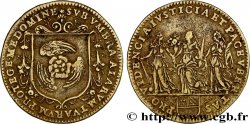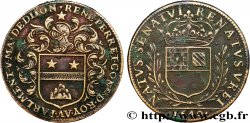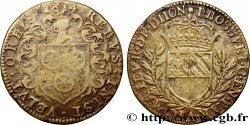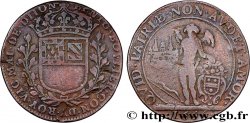fjt_116365 - DIJON (MAIRES DE ... et divers) Jeton Lt 27, Pierre de Challudet et Marie Tenon de la Guerche 1650
220.00 €约 1694.00 CNY
数量
加入购物车

种类 Jeton Lt 27, Pierre de Challudet et Marie Tenon de la Guerche
日期: 1650
材质 brass
直径 27 mm
模子方针 6 h.
重量 7,47 g.
侧面 lisse
稀少度 R1
关于品相的说明
Bel exemplaire, usure régulière au centre
出版目录中的项代码 :
正面
正面的文字 * PRE. DE. CHALVDET. ECER. ME. DHOSTEL. DV. ROY. ET. MARIE. TENON.
正面的说明书 Écus accolés de Pierre de Challudet et de Marie Tenon et surmontés d’un casque heaumé de face avec cimier et lambrequins ; au-dessous : 1614.
背面
背面的文字 * PRE. DE. CHALVDET. CHR. M. ROZ. DIION. ET. SVZAN. DE. ROCHECHOVARD.
背面的说明书 Écu aux armes de Challudet surmonté d’une couronne, entouré du collier de l’ordre de Saint-Michel et placé au-dessus de deux écussons losangés et couronnés, l’un aux armes de Dijon-Fluseaux et l’autre aux armes de Rochechouart ; au-dessous de celui de Dijon, .1637., et au-dessous du second, .1650. ; ces trois écussons sont reliés par un ruban.
评论
Au droit, l’écu de Challudet porte écartelé au 1 de Challudet, au 2 de Chaslus de Lambron, au 3 d’Alègre et au 4 d’Auvergne ; le second porte les armes de Tenon : écartelé aux 1 et 4 de sable, à une fasce d’or, aux 2 et 3, de sable à deux lions léopardés d’or. Au revers, l’écu de Pierre II de Challudet porte par contre d’or, au lion de gueules, au franc quartier d’azur, chargé d’une fleur de lys d’or.
Ce jeton est pour les parents de Pierre II de Challudet au droit et rappelle au revers les deux épouses successives de Pierre de Challudet : Rose Dijon-Fluseaux épousée en 1637 et enfin Suzanne de Rochechouart épousée en 1650, fille de Louis de Rochechouart, seigneur de La Brosse et de Montigny.
Ce jeton est pour les parents de Pierre II de Challudet au droit et rappelle au revers les deux épouses successives de Pierre de Challudet : Rose Dijon-Fluseaux épousée en 1637 et enfin Suzanne de Rochechouart épousée en 1650, fille de Louis de Rochechouart, seigneur de La Brosse et de Montigny.








 对产品描述纠错
对产品描述纠错 打印
打印 分享我的选择
分享我的选择 提问
提问 Consign / sell
Consign / sell
 产品介绍
产品介绍



